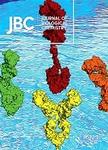版权所有:内蒙古大学图书馆 技术提供:维普资讯• 智图
内蒙古自治区呼和浩特市赛罕区大学西街235号 邮编: 010021

作者机构:Ixsys Inc San Diego CA 92121 USA
出 版 物:《JOURNAL OF BIOLOGICAL CHEMISTRY》 (生物化学杂志)
年 卷 期:1999年第274卷第39期
页 面:27371-27378页
核心收录:
学科分类:0710[理学-生物学] 071010[理学-生物化学与分子生物学] 07[理学]
主 题:氨基酸序列 抗体 单克隆/化学 抗体 单克隆/免疫学 结合部位 抗体 结直肠肿瘤 表位/分析 免疫球蛋白重链/化学 免疫球蛋白轻链/化学 免疫球蛋白可变区/化学 分子序列数据 肽库 重组融合蛋白质类/免疫学 序列比对 肿瘤细胞 培养的 动物 人类 小鼠
摘 要:A mimotope-guided strategy for engineering antibodies directed against orphan targets or antigens that are difficult to purify was developed and used to humanize the murine MRK-16 monoclonal antibody (mAb), MRK-16 recognizes a conformational epitope of a 170-kDa membrane protein, termed P-glycoprotein (P-gp). Elevated expression of P-gp on tumor cells is associated with resistance to cytotoxic drugs, a major obstacle in chemotherapy. Murine MRK-16 was used to enrich and screen a phage-displayed peptide library to identify reactive mimotopes, One peptide, termed ALR1, was enriched to a greater extent than others and subsequently was expressed as a fusion protein with glutathione S-transferase. ALR1 fusion protein bound MRK-16 specifically and inhibited binding of MRK-16 to cells expressing elevated levels of P-gp. To humanize MRK-16, the murine complementarity determining regions were grafted onto homologous human heavy and light chain variable region frameworks. Framework residues that differed between the murine MRK-16 and the homologous human templates were analyzed and subsequently, five framework positions potentially important for maintaining the specificity and affinity of MRK-16 were identified. A combinatorial library consisting of 32 variants encoding all possible combinations of murine and human residues at the five differing framework positions was expressed in a phage system. In the absence of purified P-gp, ALR1 fusion protein was used as surrogate antigen to screen the antibody library to identify the framework combination that most preserved the binding activity of the mAb. On the basis of the initial screening against the mimotope four antibody variants were selected for further characterization. The binding affinity of these variants for the ALR1 fusion protein correlated with their binding to cells expressing elevated levels of P-gp. Thus, peptide mimotopes which can be identified for virtually any antibody including those that recognize conformati